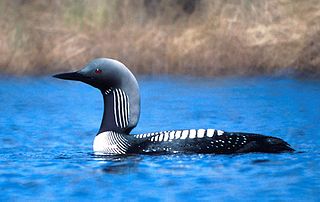
Gaviiformes is an order of aquatic birds containing the loons or divers and their closest extinct relatives. Modern gaviiformes are found in many parts of North America and northern Eurasia, though prehistoric species were more widespread.

Loons or divers are a group of aquatic birds found in many parts of North America and northern Eurasia. All living species of loons are members of the genus Gavia, family Gaviidae and order Gaviiformes.
Great Northern may refer to:

The common loon or great northern diver is a large member of the loon, or diver, family of birds. Breeding adults have a plumage that includes a broad black head and neck with a greenish, purplish, or bluish sheen, blackish or blackish-grey upperparts, and pure white underparts except some black on the undertail coverts and vent. Non-breeding adults are brownish with a dark neck and head marked with dark grey-brown. Their upperparts are dark brownish-grey with an unclear pattern of squares on the shoulders, and the underparts, lower face, chin, and throat are whitish. The sexes look alike, though males are significantly heavier than females. During the breeding season, loons live on lakes and other waterways in Canada; the northern United States ; and southern parts of Greenland and Iceland. Small numbers breed on Svalbard and sporadically elsewhere in Arctic Eurasia. Common loons winter on both coasts of the US as far south as Mexico, and on the Atlantic coast of Europe.

The black-throated loon, also known as the Arctic loon and the black-throated diver, is a migratory aquatic bird found in the northern hemisphere, primarily breeding in freshwater lakes in northern Europe and Asia. It winters along sheltered, ice-free coasts of the north-east Atlantic Ocean and the eastern and western Pacific Ocean. This loon was first described by Carl Linnaeus in 1758. It has two subspecies. It was previously considered to be the same species as the Pacific loon, of which it is traditionally considered to be a sister species, although this is debated. In a study that used mitochondrial and nuclear intron DNA, the black-throated loon was found to be sister to a clade consisting of the Pacific loon and two sister species, the common loon and the yellow-billed loon.

The Pacific loon or Pacific diver, is a medium-sized member of the loon, or diver, family.

The red-throated loon or red-throated diver is a migratory aquatic bird found in the northern hemisphere. The most widely distributed member of the loon or diver family, it breeds primarily in Arctic regions, and winters in northern coastal waters. Ranging from 55 to 67 centimetres in length, the red-throated loon is the smallest and lightest of the world's loons. In winter, it is a nondescript bird, greyish above fading to white below. During the breeding season, it acquires the distinctive reddish throat patch which is the basis for its common name. Fish form the bulk of its diet, though amphibians, invertebrates, and plant material are sometimes eaten as well. A monogamous species, red-throated loons form long-term pair bonds. Both members of the pair help to build the nest, incubate the eggs, and feed the hatched young.

Gavia Pass (el. 2621 m.) is a high mountain pass in the Italian Alps. It is the tenth highest paved road in the Alps.

The 1988 Giro d'Italia was the 71st running of the Giro d'Italia, one of cycling's Grand Tour races. The Giro started in Urbino, on 23 May, with a 9 km (5.6 mi) individual time trial and concluded in Vittorio Veneto, on 12 June, with a 43 km (26.7 mi) individual time trial. A total of 180 riders from 20 teams entered the 21-stage race, which was won by American Andrew Hampsten of the 7-Eleven–Hoonved team. The second and third places were taken by Dutchman Erik Breukink and Swiss Urs Zimmermann, respectively. It was the third time – and second successive year – in the history of the Giro that the podium was occupied solely by non-Italian riders.

Lars Jonsson is a Swedish ornithological illustrator living in Hamra in the south part of the Swedish island of Gotland. He was appointed an honorary degree by Uppsala University in 2002.

The 1989 Giro d'Italia was the 72nd edition of the Giro d'Italia, one of cycling's Grand Tours. The Giro started off in Taormina on 21 May with a 123 km (76.4 mi) flat stage that ended in Catania. The race concluded in Florence with a 53 km (32.9 mi) individual time trial on 11 June. Twenty-two teams entered the race, which was won by the Frenchman Laurent Fignon of the Super U team. Second and third respectively were the Italian Flavio Giupponi and the American rider, Andrew Hampsten.
Scarlett's shearwater is an extinct species of seabird in the petrel family Procellariidae. Its common name commemorates New Zealand palaeontologist Ron Scarlett, who recognised the bird's subfossil remains represented a distinct species.

The yellow-billed loon, also known as the white-billed diver, is the largest member of the loon or diver family. Breeding adults have a black head, white underparts and chequered black-and-white mantle. Non-breeding plumage is drabber with the chin and foreneck white. The main distinguishing feature from great northern loon is the longer straw-yellow bill which, because the culmen is straight, appears slightly uptilted.
Gaius is a Latin praenomen, or personal name, and was one of the most common names throughout Roman history. The feminine form is Gaia. The praenomen was used by both patrician and plebeian families, and gave rise to the patronymic gens Gavia. The name was regularly abbreviated C., based on the original spelling, Caius, which dates from the period before the letters "C" and "G" were differentiated. Inverted, Ɔ. stood for the feminine, Gaia.

Monte Gavia is a mountain of the Sobretta-Gavia Group in Lombardy, Italy. It has an elevation of 3,223 metres and towers above the Gavia Pass.

Monte Sobretta is the highest mountain of the Sobretta-Gavia Group in Lombardy, Italy. It has an elevation of 3,296 m s.l.m.
The Cima Coppi is the title given to the highest peak in the yearly running of the Giro d'Italia, one of cycling's Grand Tour races. The mountain that is given this title each year awards more mountains classification points to the first rider than any of the other categorized mountains in the race.

The Combination classification was a competition in the annual Giro d'Italia bicycle race. It was first introduced in the 1985 Giro d'Italia, where it was first won by the Swiss rider Urs Freuler. The classification was run annually until the 1988 Giro d'Italia, where the American Andrew Hampsten won the classification. The combination classification was replaced in the 1989 Giro d'Italia by the intergiro classification. The classification reappeared after an 11-year hiatus in 2001. It was the absent from the succeeding Giro d'Italia editions until it returned in 2006, where Paolo Savoldelli won the classification. The classification did not return in 2007, as it was replaced by the return of the Young rider classification.

La Gavia is a station on Line 1 of the Madrid Metro. It is located in fare Zone A. The station opened on 16 May 2007.











